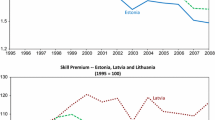Abstract
The aim of this paper is to evaluate how immigration of high-skilled workers affects the technological-knowledge bias and, in turn, the skill premium in the host countries, in particular bearing in mind the recent experience in a number of European countries. We study a skill-biased dynamic general equilibrium R&D growth model in which the standard R&D technology is modified so wage inequality results from the direction of the technological knowledge, which in turn is induced by the price channel. By solving the transitional dynamics numerically, we show that the rise of the skill premium arises from the price-channel effect, complemented with a mechanism that reflects the impact of immigration on R&D. According to our quantitative results, our model is able to account for a significant proportion of the dynamics of the skill premium in the data for a number of European countries, thus, suggesting that differences in labour skills between immigrants and natives are, in practice, an important source of skill premium variation over time.





Similar content being viewed by others
Notes
These countries are: Austria (AUT), Belgium (BEL), Czech Republic (CZR), Denmark (DNK), Finland (FIN), France (FRA), Germany (DEU), Hungary (HUN), Ireland (IRL), Italy (ITA), Luxemburg (LUX), Netherlands (NLD), Norway (NOR), Poland (POL), Portugal (PRT), Spain (ESP), Sweden (SWE), Switzerland (CHE), and the UK (GBR).
\( \varPi (k,j,t) = \bar{m}\,m(q - 1)\left[ {\frac{{p_{m} (t)\,A\,(1 - \alpha )}}{q}} \right]^{1/\alpha } \;q^{{k(j,t)\alpha^{ - 1} (1 - \alpha )}} ,\quad \bar{m} = h\;{\text{for}}\;m = H\;{\text{and}}\;\bar{m} = l\;{\text{for}}\;m = L. \)
References
Acemoglu D (2003) Patterns of skill premia. Rev Econ Stud 70:199–230
Afonso O (2006) Skill-biased technological knowledge without scale effects. Appl Econ 38(1):13–21
Afonso O, Gil PM (2013) Effects of North–South trade on wage inequality and on human-capital accumulation. Econ Model 35:481–492
Aghion P, Howitt P (1992) A model of growth through creative destruction. Econometrica 60:323–352
Alesina A, Spolaore E (1997) On the number and size of nations. Q J Econ 112:1027–1056
Azarnert L (2010) Is skilled immigration always good for growth in the receiving economy? Econ Lett 108(2):116–118
Becker G, Murphy K (1992) The division of labour, coordination costs, and knowledge. Q J Econ 107:1137–1160
Ben-Gad M (2008) Capital–skill complementarity and the immigration surplus. Rev Econ Dyn 11:335–365
Borjas G (2003) The Labor demand curve is downward sloping: reexamining the impact of immigration on the labor market. Q J Econ 118(4):1335–1374
Borjas G, Katz L (2007) The evolution of the Mexican-born workforce in the United States. NBER Chapters, In: Mexican immigration to the United States, pp 13–56
Bosetti V, Cattaneo C, Verdolini E (2015) Migration of skilled workers and innovation: a European perspective. J Int Econ 96:311–322
Card D (2009) Immigration and inequality. Am Econ Rev 99(2):1–21
Connolly M (2003) The dual nature of trade: measuring its impact on imitation and growth. J Dev Econ 72:31–55
Deding M, Hussain A, Jakobsen V, Brodmann S (2010) Immigrations and income inequality: a comparative study of Denmark and Germany, 1984–2003. Working Paper Series of the Danish National Centre for Social Research
Dinopoulos E, Segerstrom P (1999) A Schumpeterian model of protection and relative wages. Am Econ Rev 89:450–473
Dinopoulos E, Thompson P (1999) Scale effects in Schumpeterian models of economic growth. J Evolut Econ 9:157–185
Drinkwater S, Levine P, Lotti E, Pearlman J (2007) The immigration surplus revisited in a general equilibrium model with endogenous growth. J Reg Sci 47(3):569–601
Dustmann C, Frattini T, Preston I (2008) The effect of immigration along the distribution of wages. Oxf Rev Econ Policy 24(3):477–494
Favre S (2011) The impact of immigration on the wage distribution in Switzerland. University of Zurich Working Paper 22
Grossman G, Helpman E (1991) Innovation and growth in the global economy. MIT Press, Cambridge
Huber P, Tondl G (2012) Migration and regional convergence in the European Union. Empirica 39:439–460
Jones C, Romer P (2010) The new Kaldor facts: ideas, institutions, population, and human capital. Am Econ J Macroecon 2(1):224–245
Katz L, Autor D (1999) Changes in the wage structure and earnings inequality. In: Ashenfelter O, Card D (eds) Handbook of labor economics, vol 26, 3rd edn. Elsevier, Amsterdam, pp 1463–1555
Kortum S (1997) Research, patenting and technological change. Econometrica 65:1389–1419
Krusell P, Ohanian L, Ríos-Rull JV, Violante GL (2000) Capital–skill complementarity and inequality: a macroeconomic analysis. Econometrica 68(5):1029–1053
Larramoma G, Sanso M (2006) Migration dynamics, growth and convergence. J Econ Dyn Control 30(11):2261–2279
Lundborg P, Segerstrom P (2002) The growth and welfare effects of international mass migration. J Int Econ 56:177–204
OECD (2008) A profile of immigration population in the 21st century. OECD Publishing, Paris
OECD (2013) Education at a glance: OECD indicators. OECD Publishing, Paris
Ottaviano G, Peri G (2012) Rethinking the effect of immigration on wages. J Eur Econ Assoc 10(1):152–197
Reichlin P, Rustichini A (1998) Diverging patterns with endogenous labor migration. J Econ Dyn Control 22(5):703–728
Rivera-Batiz LA, Romer PM (1991) Economic integration and endogenous growth. Q J Econ 106(2):531–555
Schultz T (1975) The value of the ability to deal with disequilibria. J Econ Lit 13:827–846
Acknowledgments
We thank an anonymous Referee for valuable comments and suggestions, which allowed us to greatly improve our paper. CEF.UP—Center for Economics and Finance at University of Porto is financially supported by FCT (Fundação para a Ciência e a Tecnologia), Portugal, as part of the Strategic Project PEst-C/EGE/UI4105/2014.
Author information
Authors and Affiliations
Corresponding author
Appendix
Appendix
This appendix presents the set of parameter values used to calibrate the model. For some parameters the choice is guided by empirical findings, while other parameter values are based on theoretical specification, such that the steady-state growth rate is set at around 2 % per year. When the range of choice is large, we use a value close to some critical value (Table 2).
Rights and permissions
About this article
Cite this article
Afonso, O., Gabriel, S. & Gil, P.M. Could immigration explain wage inequality in a skill-biased technological model?. Empirica 43, 559–577 (2016). https://doi.org/10.1007/s10663-015-9305-3
Published:
Issue Date:
DOI: https://doi.org/10.1007/s10663-015-9305-3




